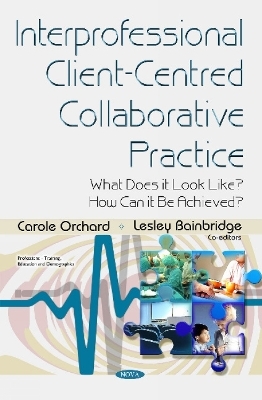
Interprofessional Client-Centred Collaborative Practice
What Does it Look Like? How Can it be Achieved?
Seiten
2015
Nova Science Publishers Inc (Verlag)
978-1-63483-754-5 (ISBN)
Nova Science Publishers Inc (Verlag)
978-1-63483-754-5 (ISBN)
Interprofessional client-centered collaborative practice (ICCCP) is collective by nature, emerging as it does at the intersection of a wide variety of professional knowledge and scopes of practice. Many studies of ICCCP focus on the determinants or inputs of collaborative practice as well as on the results, outputs, or outcomes. This is echoed methodologically, as a preponderance of ICCCP teamwork studies primarily employ interview and survey data. However, close observations are also necessary to build understanding of the collective behavioral processes of interprofessional collaboration. Many authors point out the need for more studies of the actual practices of collaboration. In many senses, ICCCP represents what Rittel and Webber (1973) have called a "wicked" problem. (p. 155) Wicked problems are "difficult or impossible to solve. Their solutions depend on incomplete, contradictory and changing requirements that are often difficult to recognize. And they are confounded by complex interdependencies between actors and agents." (Drinka & Clark, 2000, p. 37) If ever there was a wicked problem, innovation in ICCCP is surely one. As a series of possible solutions to this problem, the various case studies set out in this monograph are welcomed. Learning to become a competent health professional has always been a two-part process that which focuses on classroom' teaching and that which engages students in an apprenticeship with qualified professionals in real-world settings. Universities, colleges, and institutes depend upon practice settings for the apprenticeship education of their health professional students. Practice education (PE) settings require competent health care professionals to deliver quality care to patients. Until recently, the delivery of health profession education has been almost entirely discipline based, with each discipline educating their own students in isolation whether on campus or in the community. As is clear in this book, there is now increasing emphasis on all health care professions to learn how to be competent collaborators. This emerging shift in education has led to a new interest in different approaches to the delivery of health professional education, approaches that embrace more opportunities for interactions amongst and between learners across health and human service/social care professions. PE settings are being recognized as ideal environments for interprofessional education (IPE), in which students can witness and practice how to work interprofessionally with others on healthcare teams -- that is, to learn about, with, and from each other, for the purpose of collaboration to improve quality of care. The chapters in this book focus on the many issues that confront healthcare professionals in their efforts to provide true interprofessional collaborative care, with the patient or client as the center of focus. The term practice tends to occupy a black box in interprofessional literature. Although it is frequently invoked in considerations of collaboration, teamwork, and team working, it is seldom explicitly defined. One exception comes from Thistlethwaite, Jackson, and Moran (2013), who suggested that practice can be understood in three ways: (a) as the enactment of a role or profession, (b) as a moment of collective unity or performance, and/or (c) as a "socially institutionalized and socially acceptable form of interaction requiring cognitive understanding and reflection." (p. 54) This book deals in a number of ways with these three ideas, thus providing a better understanding of the term practice by removing it from a black box and placing it within our concept of a partnership between a team of healthcare providers. It is now recognized that effective ICCCP requires the active engagement of students from different professions using interactive learning methodologies to develop health professional students' knowledge, skills, attitudes, perceptions, and behaviors. As noted in this book, ICCCP requires a complex adult learning (andragogy) approach that is most effective when integrated throughout a program of study, moving from simple to more complex learning activities that bridge from post-secondary to practice education settings. Educational accreditation standards being developed to stimulate the advancement of IPE will have an impact on policies in both the academic and clinical settings that encompass ICCCP. Continuing professional development (CPD) is an integral part of the learning continuum to ensure that ICCCP is built on a theory-informed base and sustained in changing healthcare environments. This book will serve as a much-needed primer to inform CPD in all aspects of ICCCP. The thoughtful and clearly articulated chapters contained here are, therefore, most welcome practical guides for practice educators, and a very useful source of information for a broader audience of healthcare providers who are faced with the complex issues that confront enactment of true ICCCP.
For Complete Table of Contents, please visit our website at: https://www.novapublishers.com/catalog/product_info.php?products_id=55996
| Erscheinungsdatum | 03.12.2015 |
|---|---|
| Verlagsort | New York |
| Sprache | englisch |
| Maße | 180 x 260 mm |
| Gewicht | 576 g |
| Themenwelt | Medizin / Pharmazie ► Medizinische Fachgebiete ► Medizinethik |
| Sozialwissenschaften ► Pädagogik | |
| ISBN-10 | 1-63483-754-1 / 1634837541 |
| ISBN-13 | 978-1-63483-754-5 / 9781634837545 |
| Zustand | Neuware |
| Haben Sie eine Frage zum Produkt? |
Mehr entdecken
aus dem Bereich
aus dem Bereich
Grundlagen, Arzneimittelporträts, Anwendung
Buch | Hardcover (2024)
Urban & Fischer in Elsevier (Verlag)
69,00 €
Buch | Softcover (2022)
MWV Medizinisch Wissenschaftliche Verlagsgesellschaft
39,95 €


